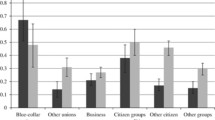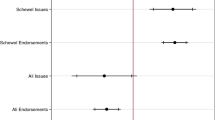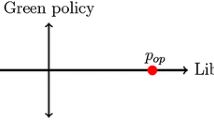Abstract
We examine group mobilization in direct democracy elections by assessing the conditions under which interests will actively support or oppose ballot measures. Motivating our analysis is that the decision to mobilize is driven by the costs and benefits of group participation, a calculus shaped by issue characteristics, state political institutions, and the electoral context. Using data from initiative and referendum measures appearing on statewide ballots from 2003 to 2008, we find that ballot measures involving social and tax issues are likely to produce competition among groups and increase the overall number of groups involved. In addition, we find that group competition and levels of mobilization increased in response to how difficult it would be for the legislature to undo the change brought about from passage of a ballot measure. Lastly, group competition and levels of mobilization increased for ballot measures appearing in nonpresidential election years and for ballot measures featuring a close election. Taken together, our results suggest that groups engage strategically in direct democracy elections to pursue a mix of policy and political goals.

Similar content being viewed by others
Notes
Additionally, 21 states allow for the popular referendum, a process whereby voters can invalidate existing state laws. While the popular referendum is seldom used, on occasion these elections can be quite contentious such as the Ohio’s Issue 2 in 2011 where voters repealed legislation that limited collective bargaining for the state’s public employees.
We exclude automatically refered referendums (many states require that voters be asked periodically if they would like to hold a constitutional convention) or referendums offered by actors besides state legislatures (e.g., the Arizona Commission on Salaries for Elective State Officers or the Florida Constitutional Revision Commission).
Robust standard errors are not an option for seemingly unrelated regression models in Stata. When the two models are run separately with robust standard errors the results are unaffected.
The specification of the SUR model may raise concerns about simultaneity, as groups may mobilize not just in response to the factors we identify, but also to the presence of opposing groups. When the analysis presented in columns two and three of Table 2 is estimated controlling for the number of opposing groups, the coefficients are positive and significant (.62 for number of con groups and .78 for the number of con groups) and the effects for Social Issue, Legislative Insulation, and Tax Increase (pro group model) are dampened, while Economic Dominance and Competitive (pro group model) falls out of significance.
References
Banducci, S. A. (1998). Direct legislation: When is it used and when does it pass? In S. Bowler, T. Donovan, & C. Tolbert (Eds.), Citizens as legislators: Direct democracy in the United States. Columbus, OH: Ohio State University.
Baumgartner, F. R., & Leech, B. L. (1998). Basic interests: The importance of groups in politics and in political science. Princeton, NJ: Princeton University Press.
Biggers, D. R. (2011). When ballot issues matter: Social issue ballot measures and their impact on turnout. Political Behavior, 33(1), 3–25.
Boehmke, F. J. (2002). The effect of direct democracy on the size and diversity of state interest group populations. The Journal of Politics, 64(3), 827–844.
Boehmke, F. J. (2005). Sources of variation in the frequency of statewide initiatives: The role of interest group populations. Political Research Quarterly, 58(4), 565–575.
Bowler, S., & Donovan, T. (1998). Demanding choices: Opinion and voting in direct democracy. Ann Arbor, MI: University of Michigan.
Bowler, S., & Donovan, T. (2004). Measuring the effect of direct democracy on state policy: Not all initiatives are created equal. State Politics & Policy Quarterly, 4(3), 345–363.
Bowler, S., & Hanneman, R. (2006). Just how pluralist is direct democracy? The structure of interest group participation in ballot proposition elections. Political Research Quarterly, 59(4), 557–568.
Bowler, S., Nicholson, S. P., & Segura, G. M. (2006). Earthquakes and aftershocks: Race, direct democracy, and partisan change. American Journal of Political Science, 50(1), 146–159.
Ceaser, J. W., & Saldin, R. P. (2005). A new measure of party strength. Political Research Quarterly, 58(2), 245–256.
Cox, G. W., & Munger, M. C. (1989). Closeness, expenditures, and turnout in the 1982 U.S. House Elections. American Political Science Review, 83(1), 217–231.
Dahl, R. A. (1961). Who governs?. New Haven, CT: Yale University Press.
Damore, D. F., Bowler, S., & Nicholson, S. P. (2012). Agenda setting by direct democracy: Comparing the initiative and the referendum. State Politics and Policy Quarterly, 12(4), 367–393.
Donovan, T., Tolbert, C., & Smith, D. (2008). Priming presidential votes with direct democracy. Journal of Politics, 70(4), 1217–1231.
Ensley, M. J., & Bucy, E. P. (2010). Do candidate positions matter? The effect of the gay marriage question on gubernatorial elections. American Politics Research, 38(1), 142–164.
Garrett, E., & Gerber, E. R. (2001). Money in the initiative and referendum process: Evidence of its effects and prospects for reform. In M. Dane Waters (Ed.), The battle over citizen lawmaking. Durham, NC: Carolina Academic Press.
Gerber, E. R. (1996). Legislatures, initiatives, and representation: The effects of state legislative institutions on policy. Political Research Quarterly, 49(2), 263–286.
Gerber, E. R. (1999). The populist paradox: Interest group influence and the promise of direct legislation. Princeton, NJ: Princeton University Press.
Gray, V., & Lowery, D. (1996). The population ecology of interest representation. Ann Arbor, MI: Lobbying Communities in the American States.
Hansen, J. M. (1985). The political economy of group membership. American Political Science Review, 79(1), 79–96.
Lowery, D., Gray, V., Wolak, J., Godwin, E., & Kilburn, W. (2005). Reconsidering the counter-mobilization hypothesis: Health policy lobbying in the American States. Political Behavior, 27(2), 99–132.
Lupia, A. (1994). Shortcuts versus encyclopedias: Information and voting behavior in California insurance reform elections. American Political Science Review, 88(1), 63–76.
Moe, T. M. (1980). The organization of interests: Incentives and the internal dynamics of political interest groups. Chicago: University of Chicago Press.
Nicholson, S. P. (2003). The political environment and ballot proposition awareness. American Journal of Political Science, 47(3), 403–410.
Nicholson, S. P. (2005). Voting the agenda: Candidates, elections, and ballot propositions. Princeton: Princeton University Press.
Nicholson, S. P. (2011). Dominating cues and the limits of elite influence. Journal of Politics, 73(4), 1165–1177.
Olson, M. (1965). The logic of collective action. Cambridge, MA: Harvard University Press.
Reilly, S. (2010). Design, meaning, and choice in direct democracy: The influences of petitioners and voters. New York: Ashgate Publishing.
Salisbury, R. H. (1969). An exchange theory of interest groups. Midwest Journal of Political Science, 13(1), 1–32.
Schattschneider, E. E. (1960). The semi-sovereign people: A realist’s view of democracy in America. New York: Holt, Rinehart and Winston.
Sears, D. O., & Citrin, J. (1985). Tax revolt: Something for nothing in California. Cambridge, MA: Harvard University Press.
Smith, D. A. (1998). Tax crusaders and the politics of direct democracy. New York: Routledge.
Smith, M. A. (2002). The contingent effect of ballot initiatives and candidate races on turnout. American Journal of Political Science, 45(3):700–706.
Smith, D. A., & Tolbert, C. J. (2004). Educated by initiative: The effects of direct democracy on citizens and political organizations in the American States. Ann Arbor, MI: University of Michigan Press.
Tolbert, C. J., Lowenstein, D. H., & Donovan, T. (1998). Election law and rules for using initiatives. In S. Bowler, T. Donovan, & C. J. Tolbert (Eds.), Citizens as legislators: Direct democracy in the United States. Columbus, OH: Ohio State University Press.
Truman, D. B. (1951). The governmental process. New York: Knopf.
Walker, J. L. (1991). Mobilizing interest groups in America. Ann Arbor, MI: University of Michigan Press.
Acknowledgments
We are thankful to Matt Barreto and Baodong Liu for helpful comments. We are indebted to Denise Roth Barber of the National Institute on Money in State Politics for providing us with her institute’s data on ballot measures. All interpretations of the data, of course, are our own. For RWJ—friend and mentor.
Author information
Authors and Affiliations
Corresponding author
Appendix. Measurement and data sources for independent variables
Appendix. Measurement and data sources for independent variables
Variable name | Measurement and data sources |
|---|---|
Issue characteristics | |
Social Issue a | Dummy variable that is coded one if a measure addresses a social issue, zero otherwise. Data from Biggers (2011) |
Tax Increase | Dummy variable that is coded one if a measure proposed to increase taxes, zero otherwise. Data from the National Conference of State Legislatures Ballot Measure Database |
Political institutions | |
Referendum | Dummy variable that is coded one if a measure was a legislatively proposed referendum, zero otherwise. Data from the National Conference of State Legislatures Ballot Measure Database |
Legislative Insulation | A nine level measure where higher values indicate greater insulation from legislative interference after passage of an initiative. Data from Bowler and Donovan (2004) |
Constitutional Amendment | Dummy variable that is coded one if the measure seeks to amend a state’s constitution, zero otherwise. Data from the National Conference of State Legislatures Ballot Measure Database |
Group Density | Interval level measure coded as the log of the number of interest groups per capita. Data from Gray and Lowery (1996) |
Economic Dominance | Interval level measure that is coded as the ratio of for profit to nonprofit interest groups in a state. Data from Gray and Lowery (1996) |
Electoral context | |
Competitive b | Dummy variable that is coded one if the final vote difference was equal to or less than five percent, zero otherwise. Data from state election returns |
Presidential Election | Dummy variable that is coded one if the measure was on the ballot during a presidential election, zero otherwise |
Party Difference | Interval level variable coded as the absolute value of the difference in Ceaser and Saldin’s (2005) major party index for the Republican and Democratic parties. Data from http://scholar.harvard.edu/saldin/data |
Rights and permissions
About this article
Cite this article
Damore, D.F., Nicholson, S.P. Mobilizing Interests: Group Participation and Competition in Direct Democracy Elections. Polit Behav 36, 535–552 (2014). https://doi.org/10.1007/s11109-013-9252-2
Published:
Issue Date:
DOI: https://doi.org/10.1007/s11109-013-9252-2




